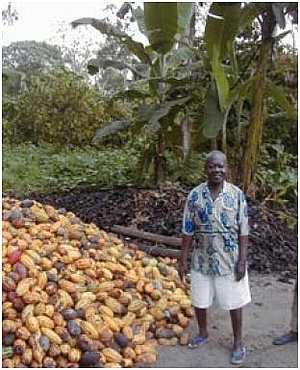What needs to be done?

What needs to be done?
The future of the world cocoa economy depends on the availability of genetic diversity and the sustainable use of this broad genetic base to breed improved varieties. Decreasing cacao genetic diversity is a serious problem and all its many causes need to be urgently addressed: the destruction of the Amazonian rainforests, the loss of traditional varieties, and threats from natural disasters and extreme weather to material conserved in genebanks and field collections. This loss of
diversity increases the vulnerability of crops such as cacao to sudden changes in climate and to the appearance of new pests and diseases.
Most of the countries involved in the improvement and production of cacao are highly dependent on genes and varieties characterized and conserved in other countries and regions. The efforts necessary to manage cacao genetic resources effectively can therefore only be carried out through international collaboration.
A coordinated Global Strategy
There is now an urgent need for an integrated Global Strategy for the Conservation and Use of Cacao Genetic Resources and the organization of related information by the cacao community. CacaoNet facilitated a series of consultations with a wide group of experts in cacao genetic resources research and management in order to develop a complete Global Strategy. This booklet summarises the full and detailed strategy, which is published by Bioversity International on behalf of CacaoNet.
The vision of the Global Strategy for the Conservation and Use of Cacao Genetic Resources is to improve the livelihoods of the 5-6 million farmers in developing countries across tropical Africa, Asia and Latin America who produce around 90% of cocoa worldwide, and the 40-50 million people who depend upon cocoa for their livelihoods.
The overall goal of the Global Strategy is to optimize the conservation and facilitate the use of cacao genetic resources, as the foundation of a sustainable cocoa economy, by bringing together national and international players in public and private sectors.
The Global Strategy promotes the rationalization of conservation efforts at regional and global levels by encouraging partnerships and sharing facilities and tasks.
The Global Strategy is intended to be used as a roadmap towards building an efficient and effective global system that focuses on the needs of small-scale producers. The Global Strategy is an important guiding document for donors, international and national research organizations and the private sector, that will facilitate the raising of support by identifying funding priorities that ensure the conservation, availability and use for improvement of cacao genetic diversity worldwide.
The objectives of the Global Strategy are to:
- Provide a platform for securing funding for the long-term, ensuring the coordination and implementation of priority cacao genetic resources research, breeding and use of improved varieties.
- Assess the global cacao genetic diversity and identify critical gaps in existing ex situ collections and prioritize collecting missions.
- Ensure the cost-effective long-term conservation of cacao genetic resources and access particularly to poorly-known gene pools.
- Strengthen the on-farm conservation of landraces and the in situ conservation of wild species especially where the natural habitat is threatened.
- Strengthen the use of the cacao genetic resources by providing support to breeders and key users through improved characterization, evaluation and support to population enhancement programmes as well as distribution of improved varieties.
- Improve the documentation on cacao germplasm and the sharing of key information of most value to users.
- Strengthen the distribution mechanism and safe movement of germplasm.
- Strengthen the networking and partnerships for global collaboration.
The expected outputs of the Global Strategy are:
- Output 1: The cacao genepool is conserved in situ and ex situ for the long term by a global network of collections maintaining the most important diversity of cacao germplasm.
- Output 2: The global system for the safe exchange of cacao germplasm is strengthened.
- Output 3: The use of cacao genetic diversity is optimized.
- Output 4: The effectiveness of global efforts to conserve and use cacao genetic resources is assured.
The rest of the booklet sets out the background to the Global Strategy and summarizes its actions in eight key strategic components.
Global Strategy
- Abstract
- Preface
- What needs to be done?
- Where we are today
- Where we want to go
- How can you help?
- Partners and acknowledgements
- References
DOWNLOAD
The entire Global Strategy document can be downloaded here: Cacaonet Global Strategy - Full document (PDF 2.4Mb)
A brochure of the Global Strategy can be downloaded here: CacaoNet Global Strategy - Brochure (PDF 2.5Mb)